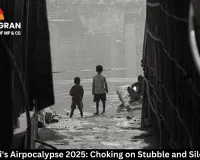Kerala's Monsoon Mayhem: Climate Denial's Deadly Cost in India's Flood-Prone South
Digital Desk

As the relentless northeast monsoon unleashes its fury on Kerala, turning lush green hills into raging rivers of mud and despair, it's hard not to feel a deep-seated anger. In the last week of October 2025, districts like Idukki, Kannur, and Malappuram have been battered by flash floods and landslides that have swept away homes, vehicles, and dreams.
The India Meteorological Department (IMD) issued orange and yellow alerts from October 18 to 24, warning of heavy rains up to 20 cm in 24 hours, but when shutters opened at dams like Kallarkutty and Mullaperiyar, low-lying areas drowned overnight.
Schools slammed shut across four districts, leaving parents scrambling, while tourist spots—from Munnar’s misty tea estates to Kochi’s backwaters—halted operations, evacuating hundreds of visitors amid rising waters. This isn't just bad weather; it's a stark reminder of climate denial's deadly toll.
Look, Kerala's no stranger to monsoons. But this year's early onslaught, fueled by a brewing Cyclone Montha in the Bay of Bengal, feels like nature's breaking point. Torrential downpours have isolated villages in Cherupuzha, toppled bridges like Chappath, and forced families to flee to relatives' homes on higher ground.
Seven houses in Vandiperiyar submerged under the Periyar River's overflow, and that's just the tip. Rescue teams are working overtime, but why does it always come to this frantic scramble? The government's preparedness—or lack of it—is a joke.
Despite IMD forecasts, roads washed out without warning, power lines snapped like twigs, and mobile networks went dark, leaving folks cut off from help. School closures? Sure, but what about long-term plans for flood-resilient classrooms? Tourist evacuations? Great, but where's the infrastructure to keep the economy afloat without risking lives?
In my view, this mayhem screams for a federal overhaul. India's central government must stop treating disasters as state-level headaches and pump resources into a national climate action plan.
We're talking upgraded early-warning systems that actually reach remote hills, not just urban alerts. Dredge those silt-choked rivers before they burst their banks. And invest in green infrastructure—mangrove barriers, elevated homes, and community drills that aren't forgotten after the rains stop.
Climate denial at the top, with leaders downplaying global warming's role in intensifying these storms, is costing lives and livelihoods. Kerala's floods aren't isolated; they're a preview of what's coming if we keep ignoring the science.
Now, here's where it gets personal for places like Ontario, Canada. Across the border, the Great Lakes are stirring with similar dread.
Climate change is already sending water levels seesawing wildly—record highs in 2017 and 2019 flooded Lake Ontario shorelines, eroding beaches, displacing families, and delaying crops. Extreme storms and heavier precipitation, straight out of climate models, mirror Kerala's woes.
Ontario's government could learn a lot: Mandate setbacks for new builds from lake edges, elevate vulnerable properties, and create a coordinated federal-provincial strategy like the International Joint Commission's push for sustainable shorelines.
Don't wait for the next "100-year flood" that hits every few years. Use Kerala's pain as a wake-up call—plan for extremes, protect communities, and ditch the denial.
At the end of the day, these floods aren't acts of God; they're the cost of inaction. Kerala’s resilient people deserve better than reactive rescues. And so does Ontario, staring down its own watery future. It's time for bold, unified action. Because next time, the waters might not recede so kindly.

1.jpg)









